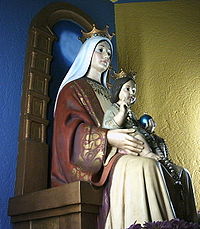- Our Lady of Coromoto
-
Our Lady of Coromoto 
Location Guanare, Portuguesa, Venezuela Date 8 September 1652 Witness Coromoto (Angel Custodio) Type Marian apparition Holy See approval 1950, pontificate of Pope Pius XII Shrine Basilica of Our Lady of Coromoto, Guanare, Venezuela. Our Lady of Coromoto (Spanish: Nuestra Señora de Coromoto, also known as the Virgin of Coromoto (Spanish: Virgen de Coromoto) is a celebrated Catholic image of an apparition of the Virgin Mary. In 1942 she was declared the Patroness of Venezuela.
Contents
Apparition
When the city of Guanare (capital of Portuguesa state) was founded in 1591, the Indian tribe who inhabited the region, the Cospes, fled to the north jungle. When the Roman Catholic Church began to evangelize its efforts were at first resisted. [1] There is a legend that the Virgin Mary appeared twice to the chief of the local tribe, once in 1651 in a river canyon when she told him to be baptised, and again, when he was still refusing Baptism, on September 8, 1652, when she appeared in his hut. This time he is said to have tried to grab her and she vanished, leaving behind a small painting of her. [2] [3] [4]
Canonization
The Venezuelan episcopate declared her as Patroness of Venezuela on 1 May 1942, which was ratified by Pope Pius XII on 7 October 1944. Pope John Paul II was crowned in his visit to the Marian shrine in Guanare, and Pope Benedict XVI elevated the National Shrine of Our Lady of Coromoto to the rank of Minor Basilica.
Footnotes
- ^ De La Torre, Miguel (2009). Hispanic American Religious Cultures. ABC-CLIO. p. 575. ISBN 978-1598841398. http://books.google.co.uk/books?id=GFrwuj-ZXMkC&pg=PA575&dq=Cacique+Coromoto+virgin&hl=en&ei=4tRHTuTGIInJsgafyvm5CQ&sa=X&oi=book_result&ct=result&resnum=4&ved=0CDoQ6AEwAw#v=onepage&q=Cacique%20Coromoto%20virgin&f=false.
- ^ Davidson, Linda Kay (2002). Pilgrimage: From the Ganges to Graceland, An Encyclopedia. ABC-CLIO. p. 214. ISBN 978-1-57607-543-2. http://books.google.co.uk/books?id=YVYkrNhPMQkC&pg=PA214&dq=Coromoto+virgin+chief&hl=en&ei=Y9ZHTpP9EIb1sgao5IDnBQ&sa=X&oi=book_result&ct=result&resnum=3&ved=0CDkQ6AEwAg#v=onepage&q=Coromoto%20virgin%20chief&f=false.
- ^ De La Torre, Miguel (2009). Hispanic American Religious Cultures. ABC-CLIO. p. 575. ISBN 978-1598841398. http://books.google.co.uk/books?id=GFrwuj-ZXMkC&pg=PA575&dq=Cacique+Coromoto+virgin&hl=en&ei=4tRHTuTGIInJsgafyvm5CQ&sa=X&oi=book_result&ct=result&resnum=4&ved=0CDoQ6AEwAw#v=onepage&q=Cacique%20Coromoto%20virgin&f=false.
- ^ Nichols, Elizabeth Gackstetter; Kimberly J. Morse (2010). Venezuela. 978-1598845693. p. 175. http://books.google.co.uk/books?id=RXgiGsCXdVUC&pg=PA175&dq=Coromoto+virgin+chief&hl=en&ei=Y9ZHTpP9EIb1sgao5IDnBQ&sa=X&oi=book_result&ct=result&resnum=2&ved=0CDMQ6AEwAQ#v=onepage&q=Coromoto%20virgin%20chief&f=false.
External links
Categories:- Marian shrines
- Depictions of the Virgin Mary
- Religion in Venezuela
- Christianity in Venezuela
- Marian apparitions
- Roman Catholic devotions
- Titles of Mary
- National symbols of Venezuela
- Roman Catholic Mariology
- September observances
Wikimedia Foundation. 2010.

